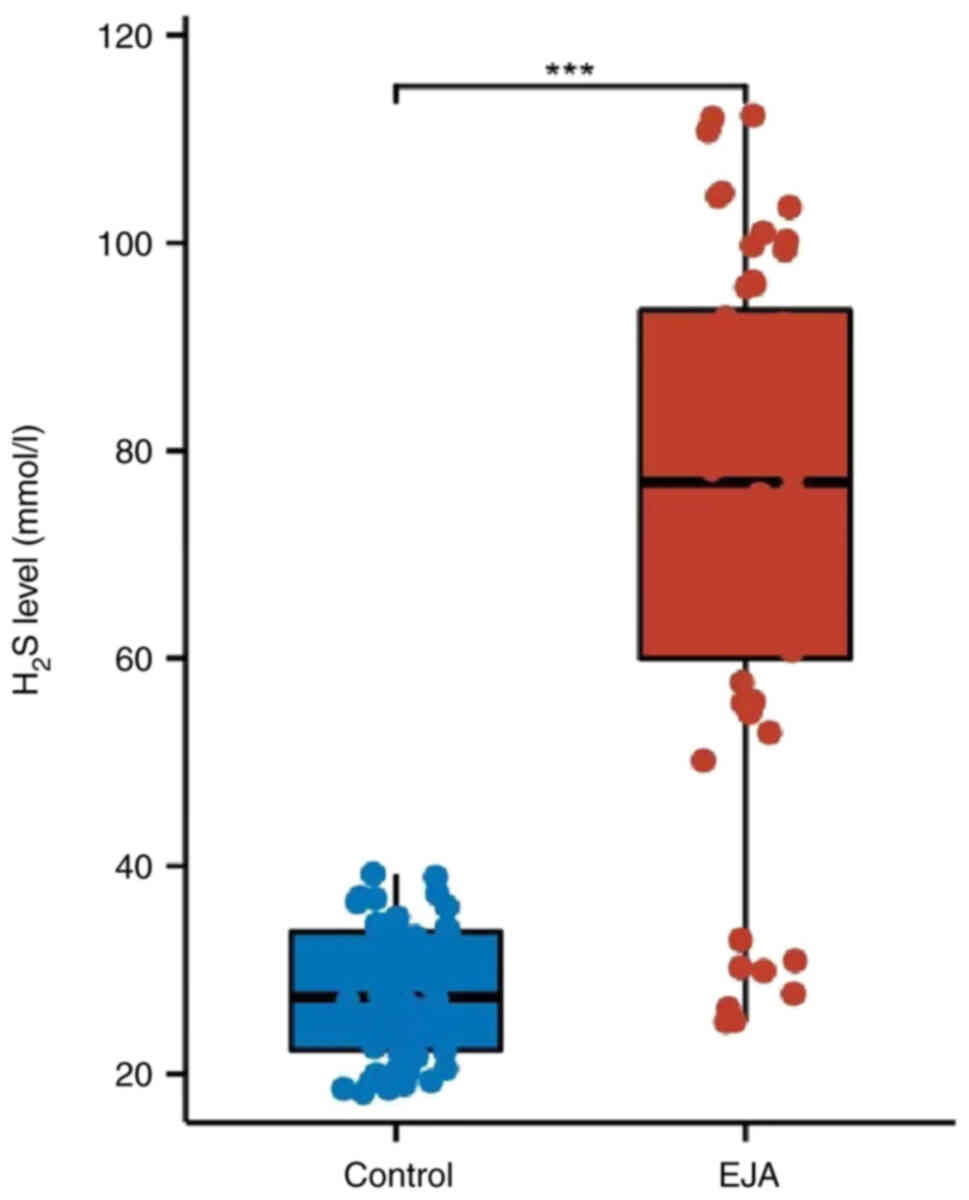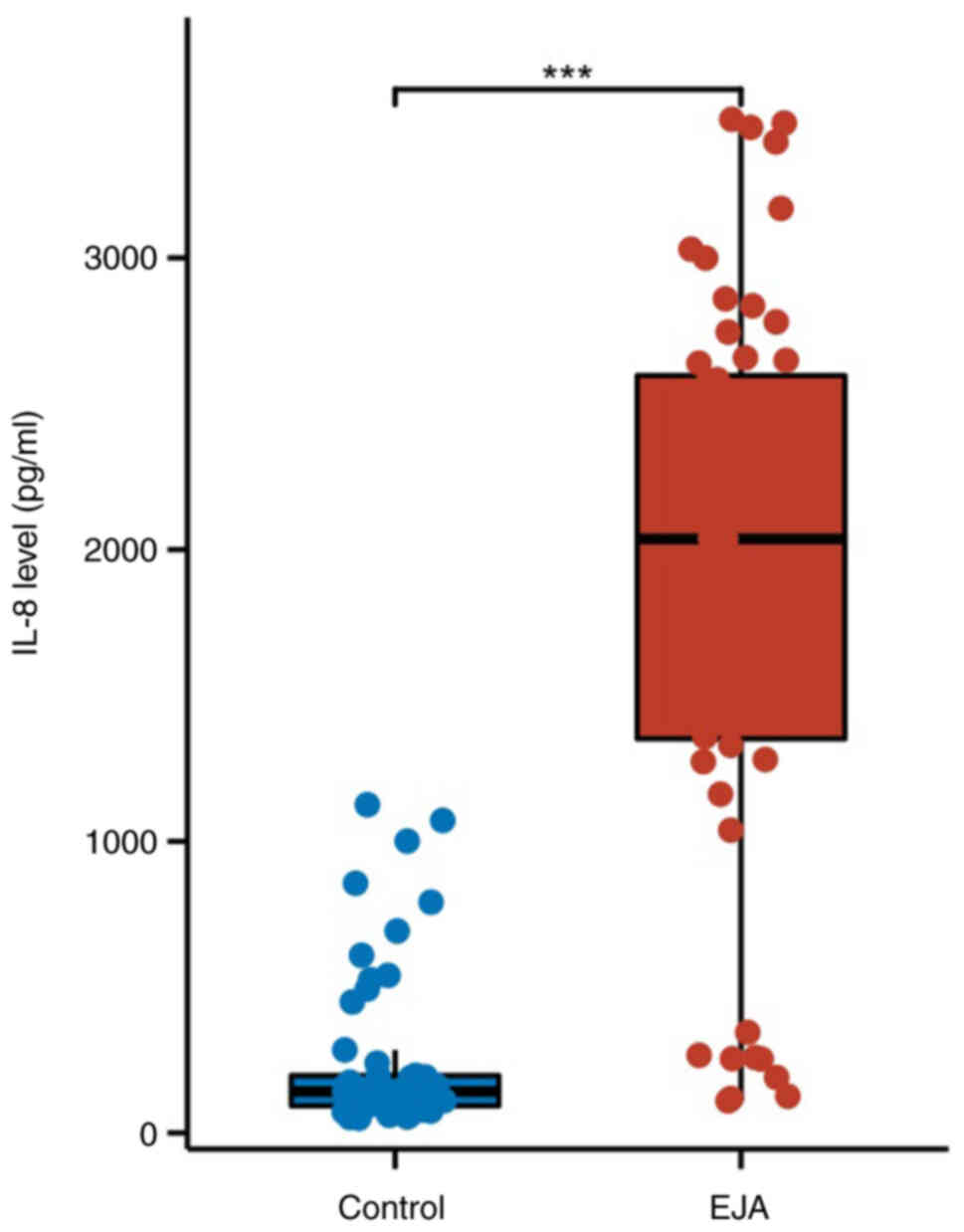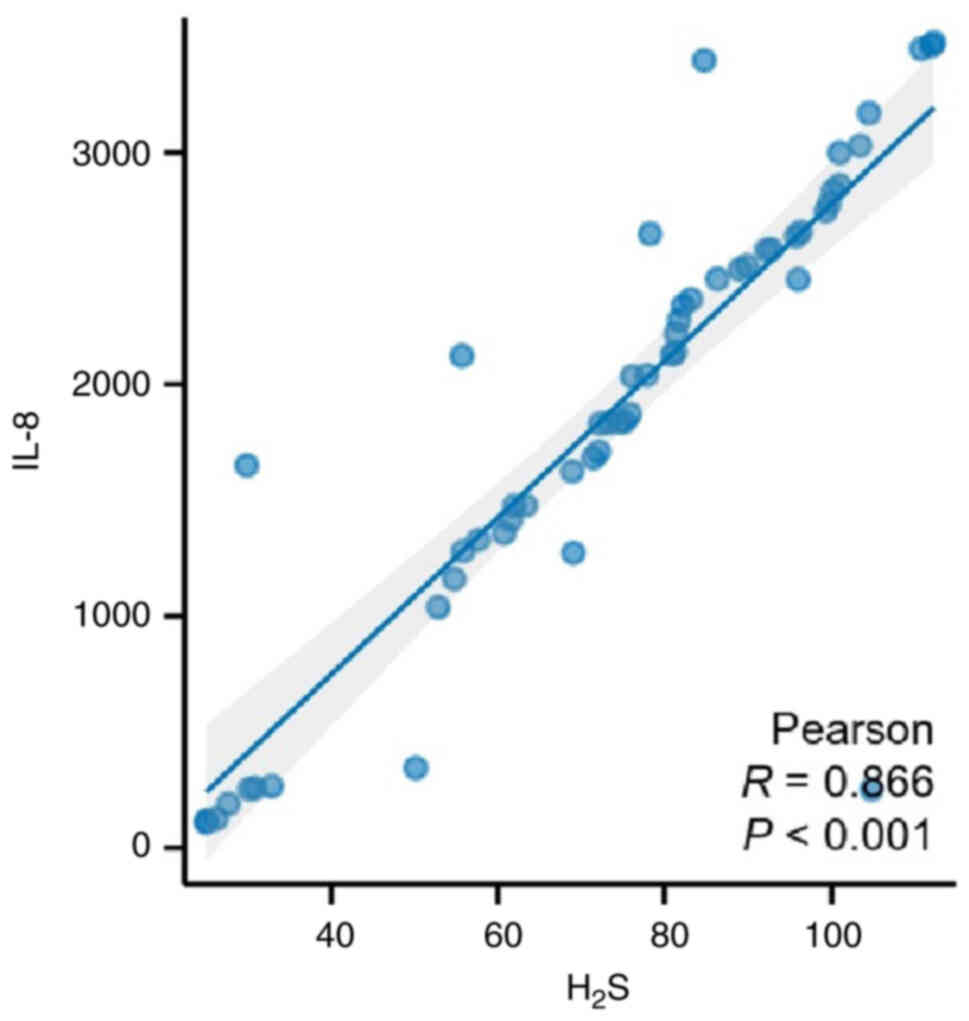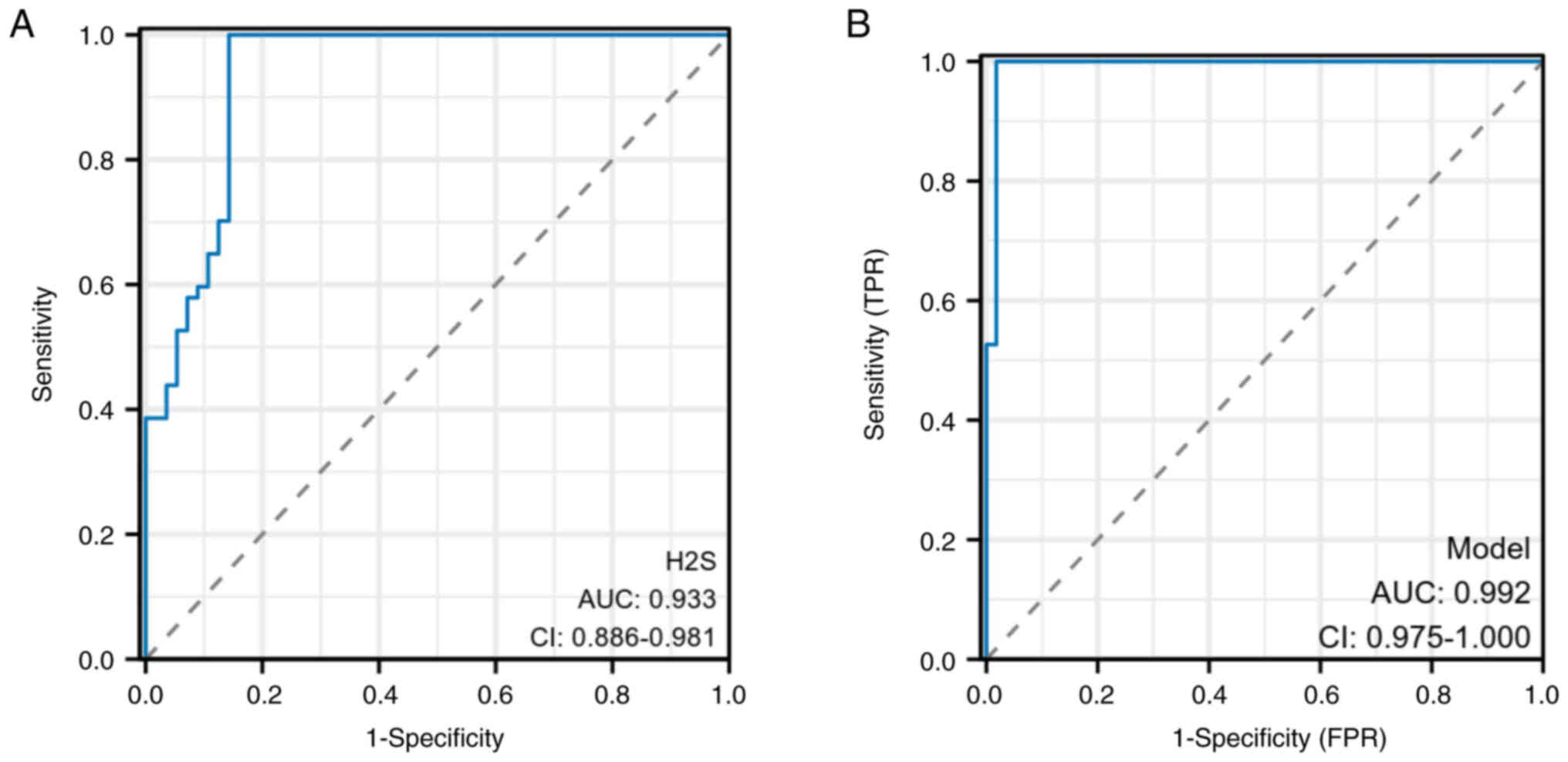|
1
|
Hasegawa S and Yoshikawa T: Adenocarcinoma
of the esophagogastric junction: Incidence, characteristics, and
treatment strategies. Gastric Cancer. 13:63–73. 2010. View Article : Google Scholar : PubMed/NCBI
|
|
2
|
McManus DT, Olaru A and Meltzer SJ:
Biomarkers of esophageal adenocarcinoma and Barrett's esophagus.
Cancer Res. 64:1561–1569. 2004. View Article : Google Scholar : PubMed/NCBI
|
|
3
|
Zhou Y, Zhang Z, Zhang Z, Wu J, Ren D, Yan
X, Wang Q, Wang Y, Wang H, Zhang J, et al: A rising trend of
gastric cardia cancer in Gansu Province of China. Cancer Lett.
269:18–25. 2008. View Article : Google Scholar : PubMed/NCBI
|
|
4
|
Zhao JJ and Liu FL: Laparoscopic proximal
gastrectomy and lymph node resection in adenocarcinoma of the
esophagogastric junction. Zhonghua Wei Chang Wai Ke Za Zhi.
25:114–119. 2022.(In Chinese). PubMed/NCBI
|
|
5
|
Guo FF, Yu TC, Hong J and Fang JY:
Emerging roles of hydrogen sulfide in inflammatory and neoplastic
colonic diseases. Front Physiol. 7:1562016. View Article : Google Scholar : PubMed/NCBI
|
|
6
|
Landry AP, Ballou DP and Banerjee R:
Hydrogen sulfide oxidation by sulfide quinone oxidoreductase.
Chembiochem. 22:949–960. 2021. View Article : Google Scholar : PubMed/NCBI
|
|
7
|
Wilkie SE, Borland G, Carter RN, Morton NM
and Selman C: Hydrogen sulfide in ageing, longevity and disease.
Biochem J. 478:3485–3504. 2021. View Article : Google Scholar : PubMed/NCBI
|
|
8
|
Dilek N, Papapetropoulos A, Toliver-Kinsky
T and Szabo C: Hydrogen sulfide: An endogenous regulator of the
immune system. Pharmacol Res. 161:1051192020. View Article : Google Scholar : PubMed/NCBI
|
|
9
|
Zhang YX, Jing MR, Cai CB, Zhu SG, Zhang
CJ, Wang QM, Zhai YK, Ji XY and Wu DD: Role of hydrogen sulphide in
physiological and pathological angiogenesis. Cell Prolif.
56:e133742023. View Article : Google Scholar : PubMed/NCBI
|
|
10
|
Ye M, Yu M, Yang D, Li J, Wang H, Chen F,
Yu H, Shen T, Zhu Q and Zhou C: Exogenous hydrogen sulfide donor
NaHS alleviates nickel-induced epithelial-mesenchymal transition
and the migration of A549 cells by regulating TGF-β1/Smad2/Smad3
signaling. Ecotoxicol Environ Saf. 195:1104642020. View Article : Google Scholar : PubMed/NCBI
|
|
11
|
Alfaro C, Sanmamed MF, Rodríguez-Ruiz ME,
Teijeira Á, Oñate C, González Á, Ponz M, Schalper KA, Pérez-Gracia
JL and Melero I: Interleukin-8 in cancer pathogenesis, treatment
and follow-up. Cancer Treat Rev. 60:24–31. 2017. View Article : Google Scholar : PubMed/NCBI
|
|
12
|
Matsushima K, Yang D and Oppenheim JJ:
Interleukin-8: An evolving chemokine. Cytokine. 153:1558282022.
View Article : Google Scholar : PubMed/NCBI
|
|
13
|
Fousek K, Horn LA and Palena C:
Interleukin-8: A chemokine at the intersection of cancer
plasticity, angiogenesis, and immune suppression. Pharmacol Ther.
219:1076922021. View Article : Google Scholar : PubMed/NCBI
|
|
14
|
McQuaid KR, Laine L, Fennerty MB, Souza R
and Spechler SJ: Systematic review: The role of bile acids in the
pathogenesis of gastro-oesophageal reflux disease and related
neoplasia. Aliment Pharmacol Ther. 34:146–165. 2011. View Article : Google Scholar : PubMed/NCBI
|
|
15
|
Isomoto H, Saenko VA, Kanazawa Y, Nishi Y,
Ohtsuru A, Inoue K, Akazawa Y, Takeshima F, Omagari K, Miyazaki M,
et al: Enhanced expression of interleukin-8 and activation of
nuclear factor kappa-B in endoscopy-negative gastroesophageal
reflux disease. Am J Gastroenterol. 99:589–597. 2004. View Article : Google Scholar : PubMed/NCBI
|
|
16
|
Jenkins GJS, Mikhail J, Alhamdani A, Brown
TH, Caplin S, Manson JM, Bowden R, Toffazal N, Griffiths AP, Parry
JM and Baxter JN: Immunohistochemical study of nuclear
factor-kappaB activity and interleukin-8 abundance in oesophageal
adenocarcinoma; a useful strategy for monitoring these biomarkers.
J Clin Pathol. 60:1232–1237. 2017. View Article : Google Scholar : PubMed/NCBI
|
|
17
|
Li Z, Xu H, Yu J, Liu C, Zheng C, Zeng R,
Xu L, Li E, Peng Y and Xu Y: The early diagnostic value of serum
interleukin-8 in esophagogastric junction adenocarcinoma. Cancer
Control. 28:107327482110048832021. View Article : Google Scholar : PubMed/NCBI
|
|
18
|
Fang Y, Yan C, Zhao Q, Xu J, Liu Z, Gao J,
Zhu H, Dai Z, Wang D and Tang D: The roles of microbial products in
the development of colorectal cancer: A review. Bioengineered.
12:720–735. 2021. View Article : Google Scholar : PubMed/NCBI
|
|
19
|
Yue T, Li J, Zhu J, Zuo S, Wang X, Liu Y,
Liu J, Liu X, Wang P and Chen S: Hydrogen sulfide creates a
favorable immune microenvironment for colon cancer. Cancer Res.
83:595–612. 2023. View Article : Google Scholar : PubMed/NCBI
|
|
20
|
Ascenção K, Lheimeur B and Szabo C:
Regulation of CyR61 expression and release by 3-mercaptopyruvate
sulfurtransferase in colon cancer cells. Redox Biol. 56:1024662022.
View Article : Google Scholar : PubMed/NCBI
|
|
21
|
Hale VL, Jeraldo P, Mundy M, Yao J, Keeney
G, Scott N, Cheek EH, Davidson J, Greene M, Martinez C, et al:
Synthesis of multi-omic data and community metabolic models reveals
insights into the role of hydrogen sulfide in colon cancer.
Methods. 149:59–68. 2018. View Article : Google Scholar : PubMed/NCBI
|
|
22
|
Li Y, Zhou J, Wang L and Xie Z: Endogenous
hydrogen sulfide-triggered MOF-based nanoenzyme for synergic cancer
therapy. ACS Appl Mater Interfaces. 12:30213–30220. 2020.
View Article : Google Scholar : PubMed/NCBI
|
|
23
|
Liu N, Tseng Y, Zhang H and Chen J: The
role of exhaled hydrogen sulfide in the diagnosis of colorectal
adenoma. Can J Infect Dis Med Microbiol. 2021:80463682021.
View Article : Google Scholar : PubMed/NCBI
|
|
24
|
Gai JW, Qin W, Liu M, Wang HF, Zhang M, Li
M, Zhou WH, Ma QT, Liu GM, Song W, et al: Expression profile of
hydrogen sulfide and its synthases correlates with tumor stage and
grade in urothelial cell carcinoma of bladder. Urol Oncol.
34:166.e15–e120. 2016. View Article : Google Scholar : PubMed/NCBI
|
|
25
|
Cao X, Ding L, Xie ZZ, Yang Y, Whiteman M,
Moore PK and Bian JS: A review of hydrogen sulfide synthesis,
metabolism, and measurement: Is modulation of hydrogen sulfide a
novel therapeutic for cancer? Antioxid Redox Signal. 31:1–38. 2019.
View Article : Google Scholar : PubMed/NCBI
|
|
26
|
Cai WJ, Wang MJ, Ju LH, Wang C and Zhu YC:
Hydrogen sulfide induces human colon cancer cell proliferation:
Role of Akt, ERK and p21. Cell Biol Int. 34:565–572. 2010.
View Article : Google Scholar : PubMed/NCBI
|
|
27
|
Furne J, Springfield J, Koenig T, DeMaster
E and Levitt MD: Oxidation of hydrogen sulfide and methanethiol to
thiosulfate by rat tissues: A specialized function of the colonic
mucosa. Biochem Pharmacol. 62:255–259. 2001. View Article : Google Scholar : PubMed/NCBI
|
|
28
|
Munteanu C, Turnea MA and Rotariu M:
Hydrogen Sulfide: An emerging regulator of oxidative stress and
cellular homeostasis-a comprehensive one-year review. Antioxidants
(Basel). 12:17372023. View Article : Google Scholar : PubMed/NCBI
|
|
29
|
Khattak S, Rauf MA, Khan NH, Zhang QQ,
Chen HJ, Muhammad P, Ansari MA, Alomary MN, Jahangir M, Zhang CY,
et al: Hydrogen sulfide biology and its role in cancer. Molecules.
27:33892022. View Article : Google Scholar : PubMed/NCBI
|
|
30
|
Shackelford RE, Mohammad IZ, Meram AT, Kim
D, Alotaibi F, Patel S, Ghali GE and Kevil CG: Molecular functions
of hydrogen sulfide in cancer. Pathophysiology. 28:437–456. 2021.
View Article : Google Scholar : PubMed/NCBI
|
|
31
|
Lin H, Yu Y, Zhu L, Lai N, Zhang L, Guo Y,
Lin X, Yang D, Ren N, Zhu Z and Dong Q: Implications of hydrogen
sulfide in colorectal cancer: Mechanistic insights and diagnostic
and therapeutic strategies. Redox Biol. 59:1026012023. View Article : Google Scholar : PubMed/NCBI
|
|
32
|
Sakuma S, Minamino S, Takase M, Ishiyama
Y, Hosokura H, Kohda T, Ikeda Y and Fujimoto Y: Hydrogen sulfide
donor GYY4137 suppresses proliferation of human colorectal cancer
Caco-2 cells by inducing both cell cycle arrest and cell death.
Heliyon. 5:e022442019. View Article : Google Scholar : PubMed/NCBI
|













